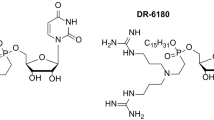Abstract
The exclusively gram-positive antibacterial spectrum of the lipopeptide daptomycin (LY146032) suggests that the underlying basis for intrinsic resistance in gram-negative organisms involves envelope impermeability. This study was undertaken to determine whether the outer membranes ofPseudomonas aeruginosa andPasteurella multocida can be rendered permeable to daptomycin by experimental modifications that result in susceptibility of gram-negative bacteria to lipophilic molecules. Turbidimetric growth assays revealed sublethal concentrations of polymyxin B or ethylenediaminetetraacetate (EDTA) sensitized all strains examined to the hydrophobic antibiotic novobiocin. Neither permeabilizer renderedPs. aeruginosa or a hydrophilicPa. multocida variant susceptible to daptomycin; however, polymyxin B sensitized a hydrophobicPa. multocida variant, whereas EDTA did not. Cells cultured with sublethal concentrations of polymyxin B or EDTA retained negatively charged cell surfaces comparable to those of control cells. Growth ofPa. multocida strains in the presence of polymyxin B did not result in modification of cell envelope lipid composition. These findings indicate that the ability of the outer membrane to retard the diffusion of daptomycin does not require normally intact structure, thereby suggesting that the residual negative charge of the cell surface may preclude interaction with the acidic antibiotic owing to electrostatic repulsion.
Similar content being viewed by others
Literature Cited
Allen NE, Hobbs Jr. JN, Alborn Jr WE (1987) Inhibition of peptidoglycan biosynthesis in gram-positive bacteria by LY146032. Antimicrob Agents Chemother 31:1093–1099
Ames BN, Dubin DT (1960) The role of polyamines in the neutralization of bacteriophage deoxyribonucleic acid. J Biol Chem 235:769–775
Brogden KA, Rimler RB (1982) Lysates of turkey-grownPasteurella multocida: examination of vaccine preparations by electron microscopy. Am J Vet Res 43:304–309
Champlin FR, Gilleland Jr. HE, Conrad RS (1983) Conversion of phospholipids to free fatty acids in response to acquisition of polymyxin resistance inPseudomonas aeruginosa. Antimicrob Agents Chemother 24:5–9
Champlin FR, Hart ME, Darnell KR (1988) Low propensity for poultry isolates ofPasteurella multocida to acquire adaptive resistance to oxytetracycline. Avian Dis 32:478–482
Conrad RS, Galanos C (1989) Fatty acid alterations and polymyxin B binding by lipopolysaccharides fromPseudomonas aeruginosa adapted to polymyxin B resistance. Antimicrob Agents Chemother 33:1724–1728
Darnell KR, Hart ME, Champlin FR (1987) Variability of cell surface hydrophobicity amongPasteurella multocida somatic serotype andActinobacillus lignieresii strains. J Clin Microbiol 25:67–71
Gilleland Jr. HE, Farley LB (1982) Adaptive resistance to polymyxin inPseudomonas aeruginosa due to an outer membrane impermeability mechanism. Can J Microbiol 28:830–840
Gilleland LB, Gilleland HE, Gibson JA, Champlin FR (1989) Adaptive resistance to aminoglycoside antibiotics inPseudomonas aeruginosa. J Med Microbiol 29:41–50
Hancock REW, Wong PGW (1984) Compounds which increase the permeability of thePseudomonas aeruginosa outer membrane. Antimicrob Agents Chemother 26:48–52
Hart ME, Champlin FR (1988) Susceptibility to hydrophobic molecules and phospholipid composition inPasteurella multocida andActinobacillus lignieresii. Antimicrob Agents Chemother 32:1354–1359
Hunt AH, Molloy RM, Occolowitz JL, Marconi GG, Debono M (1984) Structure of the major glycopeptide of the teicoplanin complex. J Am Chem Soc 106:4891–4895
Jones RN, Barry AL (1987) Antimicrobial activity and spectrum of LY146032, a lipopeptide antibiotic, including susceptibility testing recommendations. Antimicrob Agents Chemother 31:625–629
Lakey JH, Lea EJA (1986) The role of acyl chain character and other determinants on the bilayer activity of A21978C an acidic lipopeptide antibiotic. Biochim Biophys Acta 859:219–226
Leive L (1974) The barrier function of the gram-negative envelope. Ann NY Acad Sci 235:109–127
Lugtenberg B, van Boxtel R, de Jong M (1984) Atrophic rhinitis in swine: correlation ofPasteurella multocida pathogenicity with membrane protein and lipopolysaccharide patterns. Infect Immun 46:48–54
Mackey BM (1983) Changes in antibiotic sensitivity and cell surface hydrophobicity inEscherichia coli injured by heating, freezing, drying or gamma radiation. FEMS Microbiol Lett 20:395–399
Manning PJ, Naasz MA, DeLong D, Leary SL (1986) Pasteurellosis in laboratory rabbits: characterization of lipopolysaccharides ofPasteurella multocida by polyacrylamide gel electrophoresis, immunoblot techniques, and enzyme-linked immunosorbent assay. Infect Immun 53:460–463
Nikaido H (1976) Outer membrane ofSalmonella typhimurium: transmembrane diffusion of some hydrophobic substances. Biochim Biophys Acta 433:118–132
Nikaido H, Vaara M (1985) Molecular basis of bacterial outer membrane permeability. Microbiol Rev 49:1–32
Rimler RB, Rebers PA, Phillips M (1984) Lipopolysaccharides of the Heddleston serotypes ofPasteurella multocida. Am J Vet Res 45:759–763
Stendahl O, Edebo L, Magnusson K-E, Tagesson C, Hjerten S (1977) Surface-charge characteristics of smooth and roughSalmonella typhimurium bacteria determined by aqueous two-phase partitioning and free zone electrophoresis. Acta Pathol Microbiol Scand Sect B 85:334–340
Sud IJ, Feingold DS (1975) Detection of agents that alter the bacterial cell surface. Antimicrob Agents Chemother 8:34–37
Suling WJ, O'Leary WM (1977) Lipids of antibiotic-resistant and-susceptible members of theEnterobacteriaceae. Can J Microbiol 23:1045–1051
Thies KL, Champlin FR (1989) Compositional factors influencing cell surface hydrophobicity ofPasteurella multocida variants. Curr Microbiol 18:385–390
Tsuchido T, Takano M (1988) Sensitization by heat treatment ofEscherichia coli K-12 cells to hydrophobic antibacterial compounds. Antimicrob Agents Chemother 32:1680–1683
Vaara M, Vaara T (1983) Polycations as outer membrane-disorganizing agents. Antimicrob Agents Chemother 24:114–122
Yoshimura F, Nikaido H (1982) Permeability ofPseudomonas aeruginosa outer membrane to hydrophilic solutes. J Bacteriol 152:636–642
Author information
Authors and Affiliations
Rights and permissions
About this article
Cite this article
Champlin, F.R., Hart, M.E. Cell envelope impermeability to daptomycin inPseudomonas aeruginosa andPasteurella multocida . Current Microbiology 21, 367–372 (1990). https://doi.org/10.1007/BF02199439
Issue Date:
DOI: https://doi.org/10.1007/BF02199439




